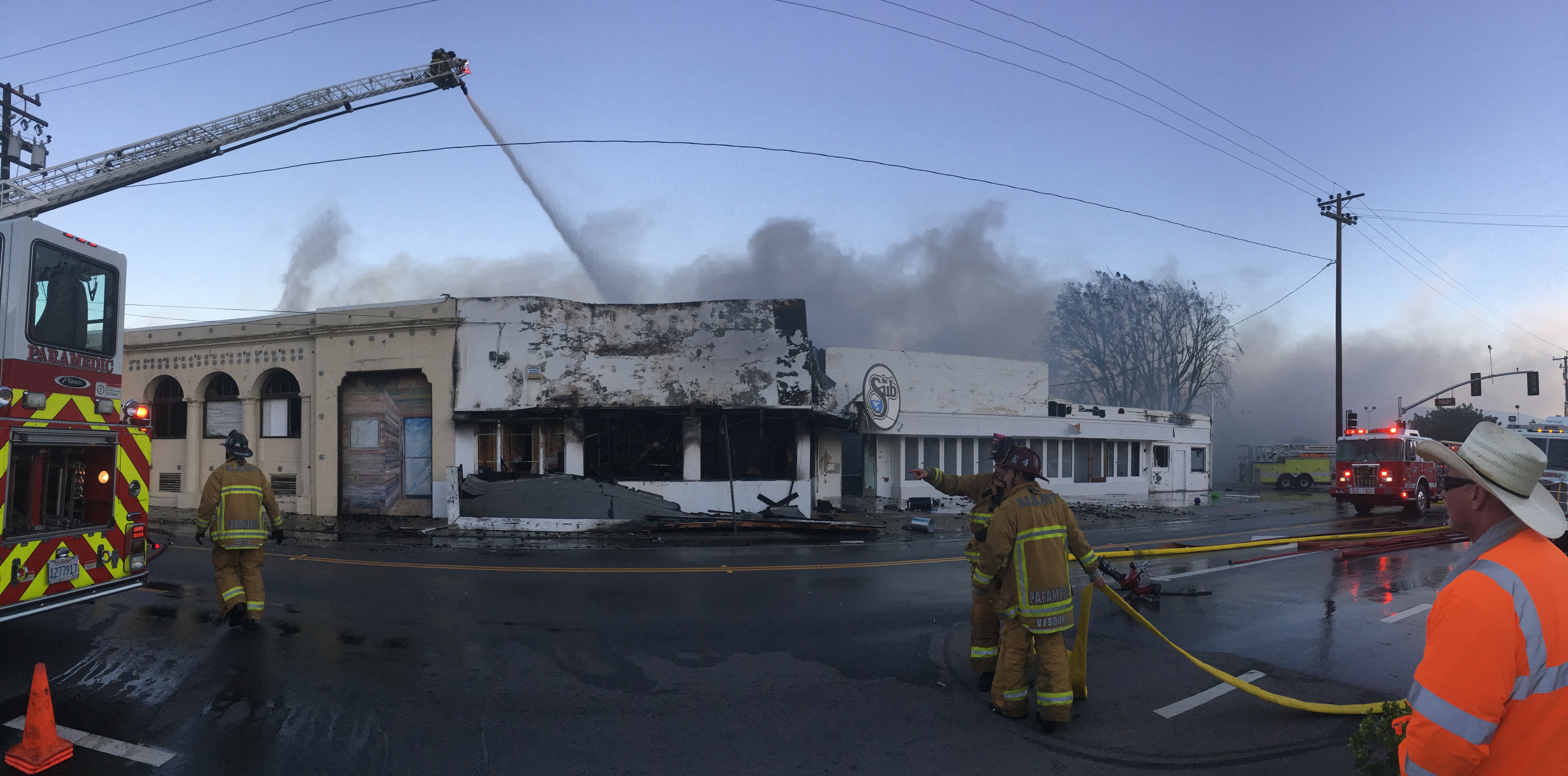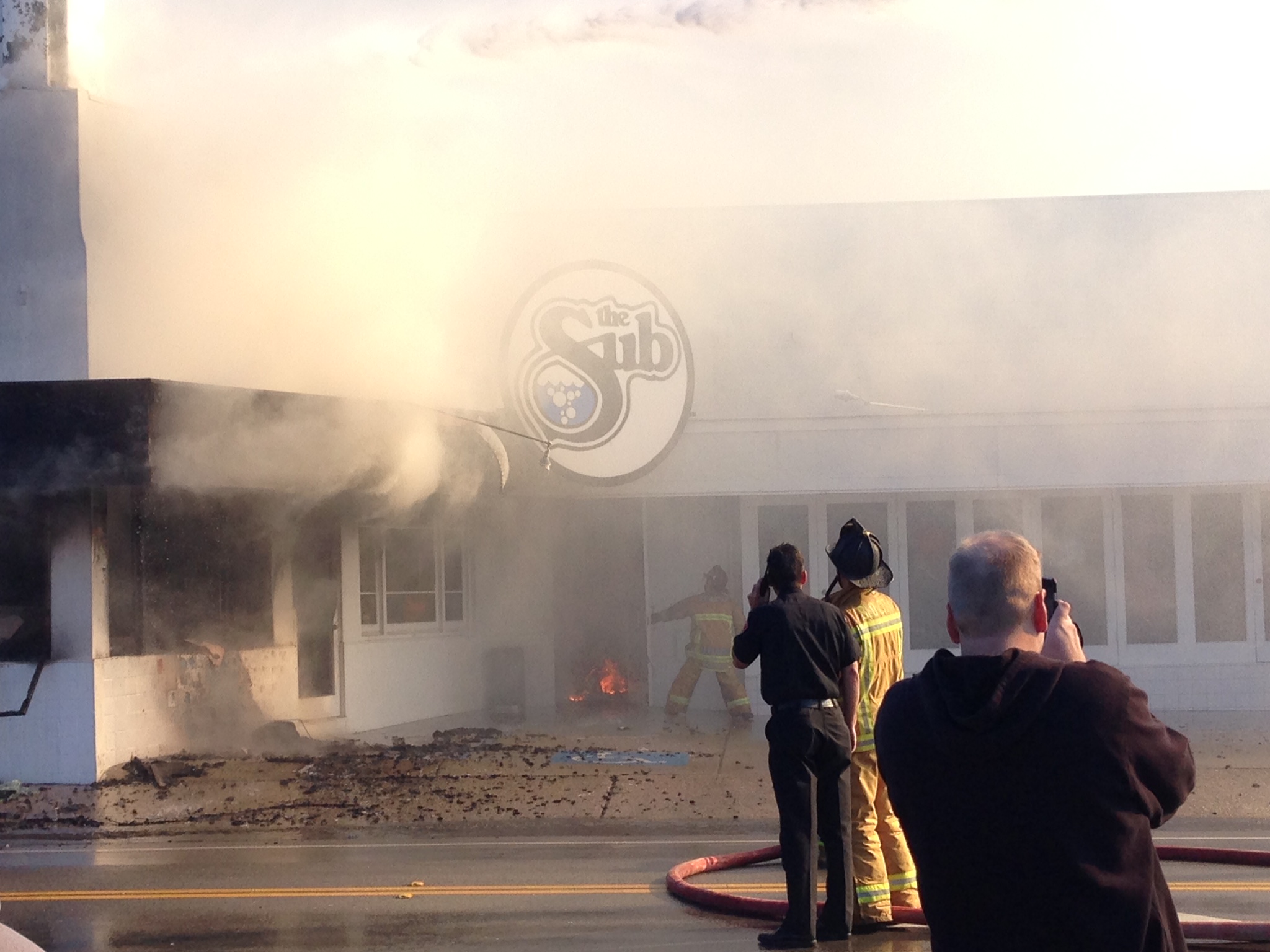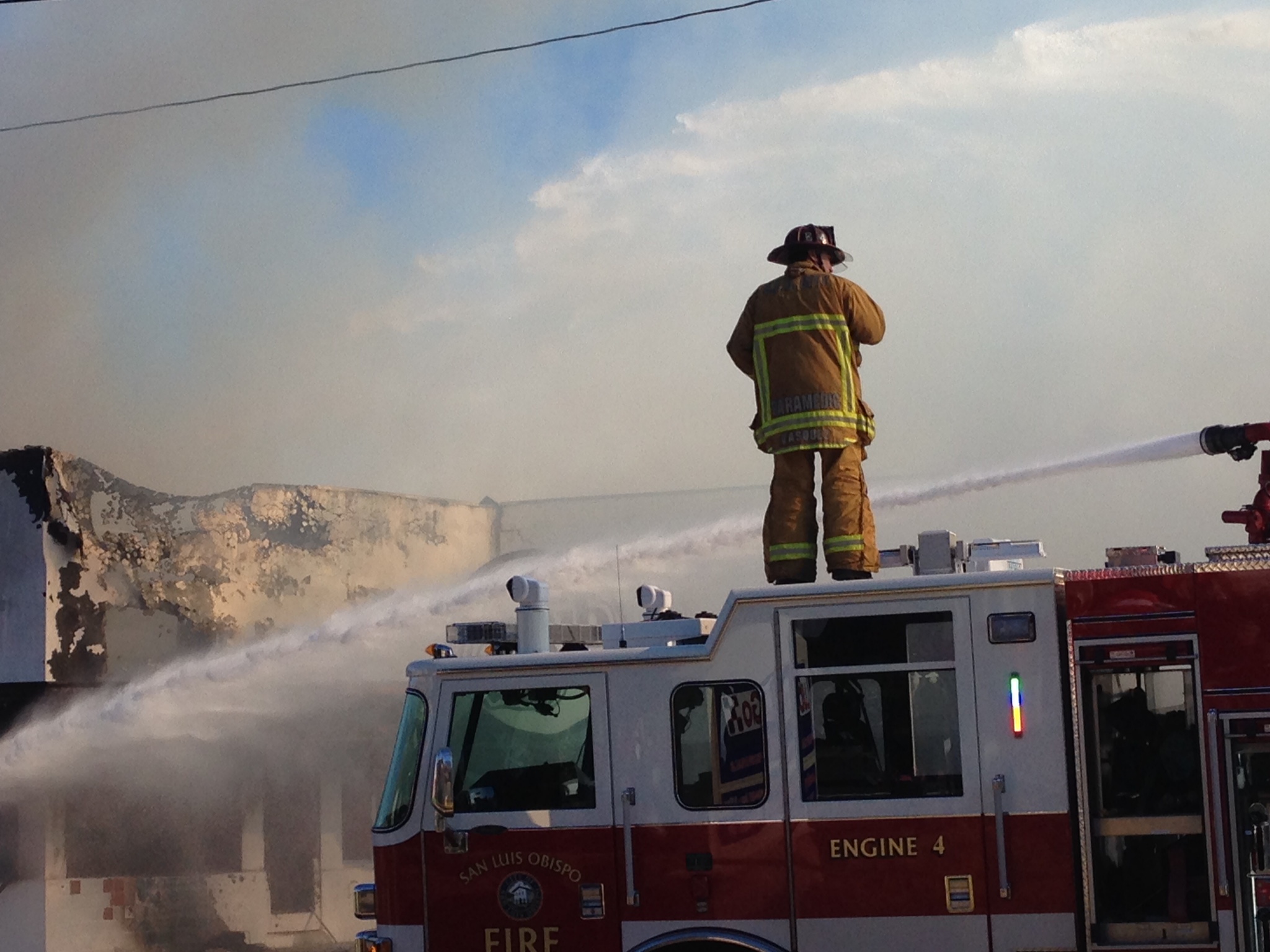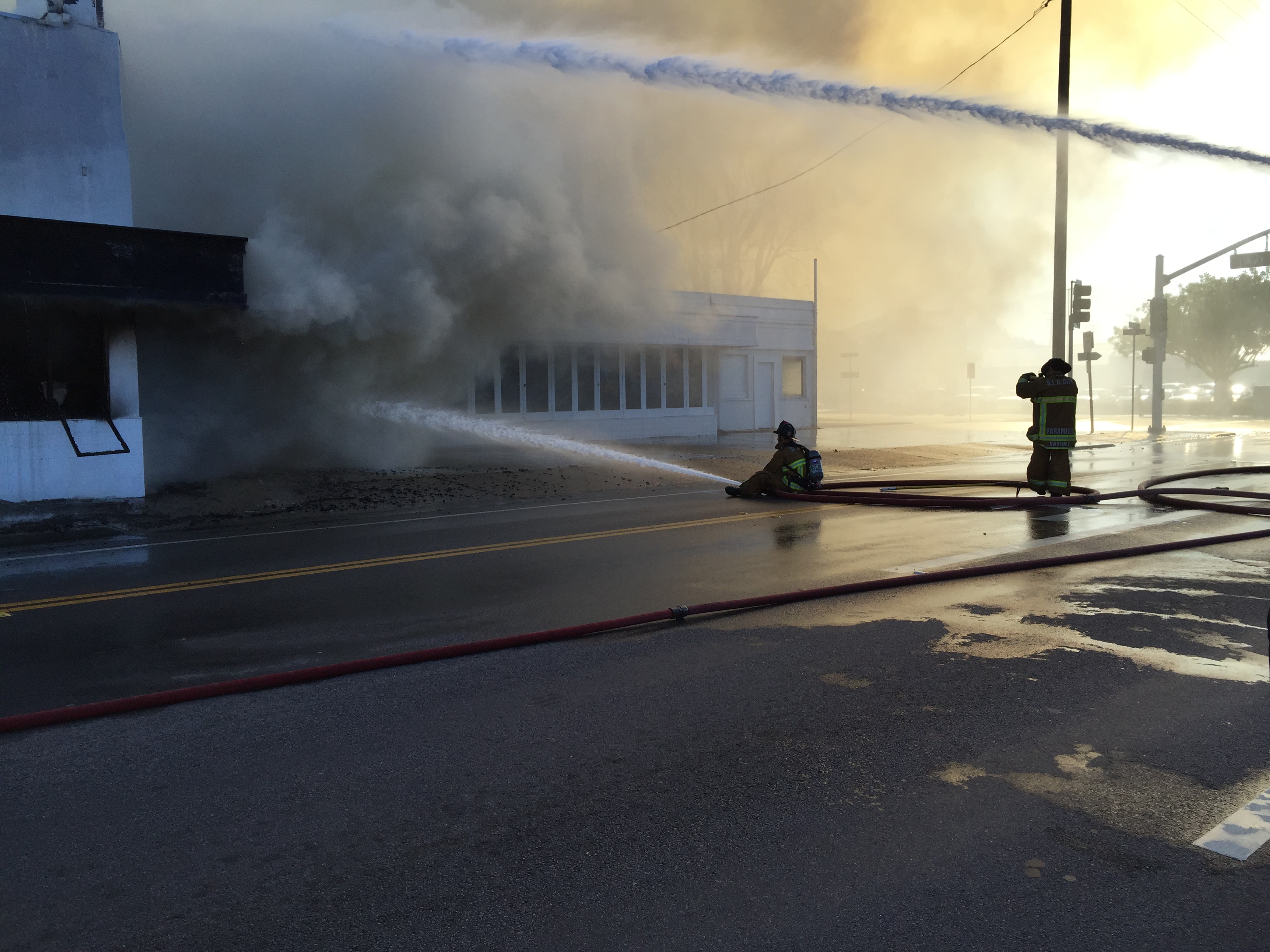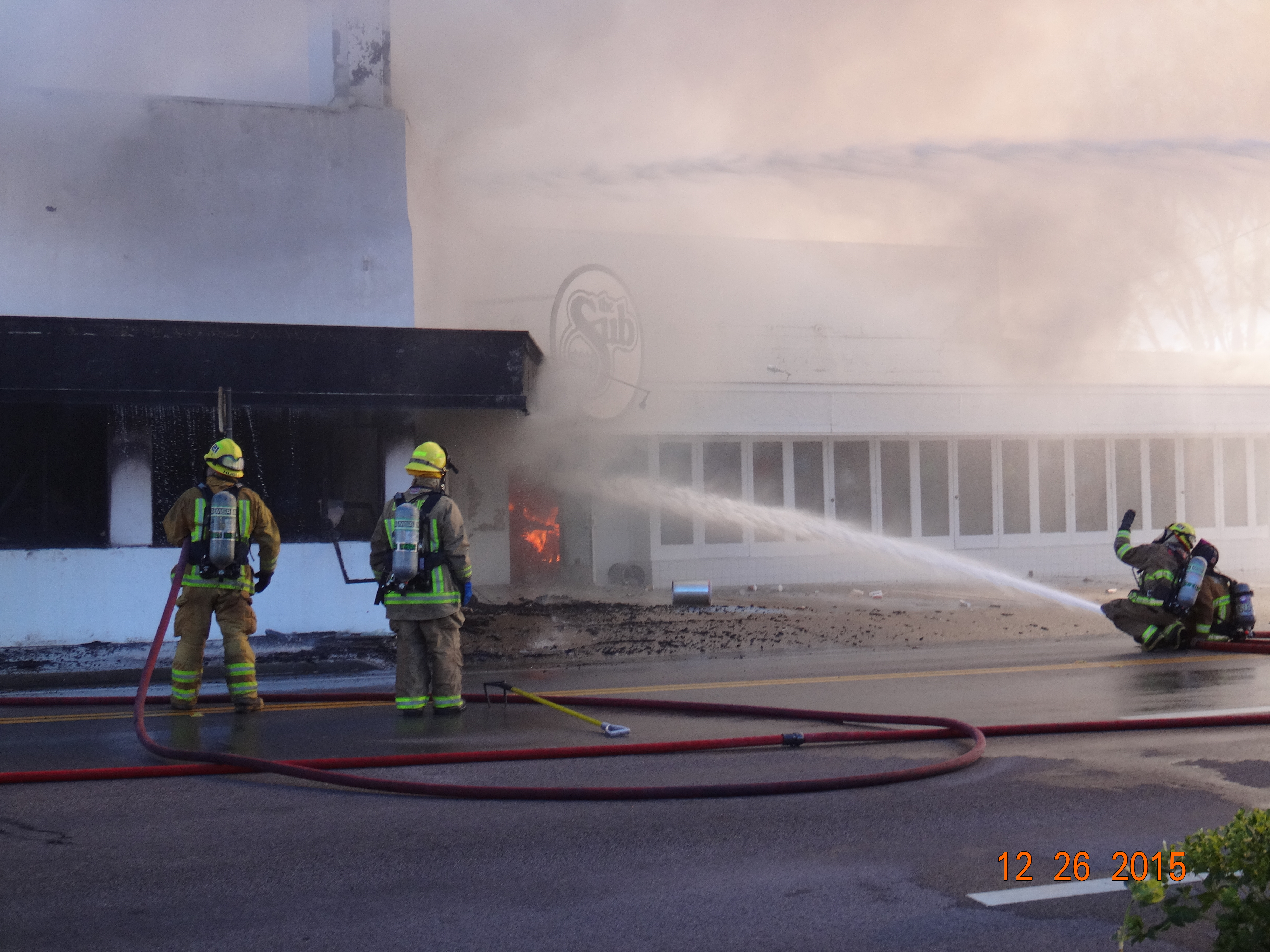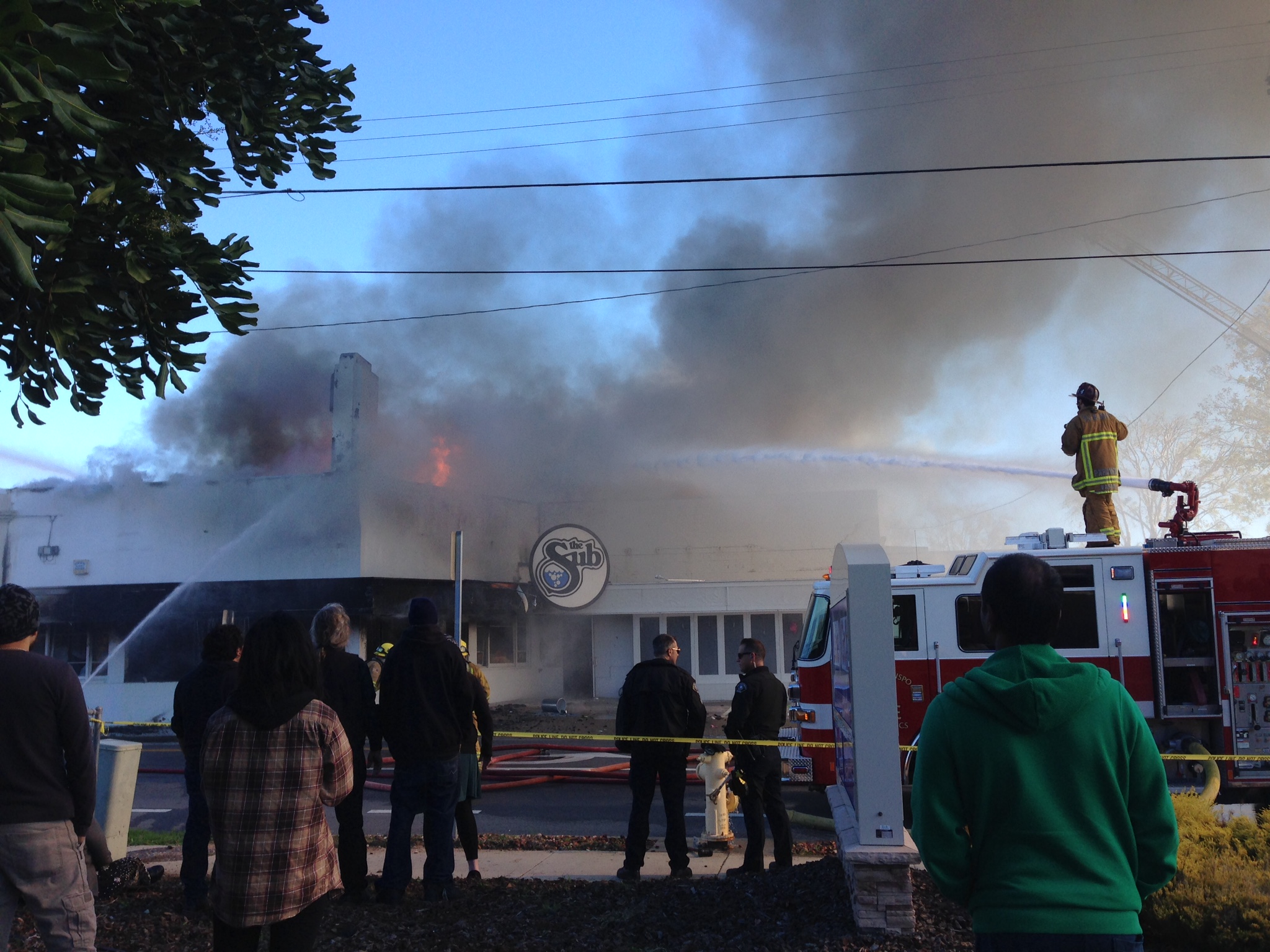The Sub Burndown
Saturday December 26, 2015
Section 1
- The Sub Fire -
Comments, Observations, & Corrections on Narrative Supplement of San Luis Obispo City Fire Department Captain Mark Vasquez
It was not written immediately after the fire which is SLO City FD policy. Apparently the report wasn't written until it could likely be coordinated with others.
Having been at the fire from the beginning myself, so much of what Vasquez states is completely at odds with both the reality as observed, and as seen through the many photos and videos recorded during the early portion of the fire.
Vasquez states when he arrived, the fire was well established and involved a large portion of the front of the building due to floor-to-ceiling flames observed inside the fire area. Vasquez is either inexperienced with structural fires, has failing vision, or is merely saying what needs to be said to excuse the inexcusable conduct and behavior.
The fire Vasquez observed was only burning 24" deep in three of five window boxes in the front of the store. Initially it was only in the window boxes. Whoever put the unknown incendiary device through our front window, we feel, squirted it on the back wall of the window box on the Higuera Street side. This explains why the fire is burning so well on the whole surface of the back of the window box. Remembering we were open and a customer was in the front room when the flammable agent was ignited, he heard the first window blow out from inside the front room. We know the fire did not come from inside the store [see photos: 2 burn patterns on floor of window box]. We also know that the contents of the front room were mostly non-flammable - a glass mirrored back wall, and glass shelving with glass and ceramic water pipes and hookahs. In front of this were glass and metal display cases with glass shelving full of glass and ceramic hand pipes. Nothing here will burn even when exposed to fire.
The flames were not floor-to-ceiling but went from the raised platform in the window box (immediately below the windows) to the window box ceiling directly above the window box [see videos: 1) earliest of window, 2) later of window] - roughly a 6' tall space, 24" deep, separated by a partitioning wall from the main store interior. (The partition wall and inside shelving are still mostly intact and can be examined at the fire scene [see photo: remaining wall].)
Section 2
- Square Deal Recordings & Supplies (SDRS) Fire -
Section 3
- San Luis Obispo City Fire Department (SLO City FD) Issues -
In his second paragraph, Vasquez puts out the fire but claims it had no effect on the deeper interior fire still burning. This is untrue. Multiple videos and still photos taken at this time show there is no fire burning behind the window boxes once the window box fire was put out [see video/photo: no fire behind window box]. The fire was still burning directly above the window box in the top front wall on Higuera Street. It was venting out the 24"x24" louver on the end of the peaked roof over the front room and the 36"x36" louver at the peaked end of the main room roof. It was also venting out a 2'x3' roof hatch the firemen had opened. Because the fire was venting well, there was only light smoke in the main big display room and no dense black smoke, and no reason that the fire could not have been easily put out at this point [see video: fire venting out vent].
After finally looking through The Sub's front door, 20 minutes into the fire, Vasquez goes on to state he saw heavy fire rolling the entire ceiling of the interior room. This is not possible for numerous reasons: The main room roof/ceiling is a raised, SEALED membrane roof and insufficient oxygen would be present once it filled with smoke to support heavy fire. All fire venting was outward to the front portion of The Sub already on fire through both the louver and the roof hatch holes. There was no venting on the main roof until firemen cut holes to draw the fire further into the roof [see Matt Callahan's narrative].
Vasquez further states that the entire huge spacious main room was full of dense black smoke all the way down to the floor and it felt hot. A great excuse not to fight the fire but totally UNTRUE! [see video: main room/no black smoke]. Ample video and still photos would confirm Vasquez's statement if it were true but, instead, we see when he first opens the door, no dense black smoke coming from any openings at this early stage of the fire. We also see no smoke stains on remaining exterior parts of the structure [see photo: doors/limited smoke stains] and we can easily see into the structure. You can see merchandise to the right burning and no effort to put it out. You can see in all the way to the back wall through the front door - No heavy black smoke [see video: merchandise burning]. Vasquez is misstating the facts of the situation to excuse not fighting a very fightable fire.
Vasquez then states he is afraid the overhanging roof (façade?) over the front door would fail and trap firemen inside the building. Since no part of the structure that supports the overhang by the door was on fire, this makes no sense. By this time, both rear doors at 100 Pismo Street were wide open and in plain sight from the entrance for easy firefighter exiting if needed. Also, the doors to 283 Higuera Street were cut open which offered easy access to fight the fire in the main building from behind a 13” thick masonry wall. Better yet, if afraid of the overhanging roof, quickly put a fireman's brace up to support it or enter through either rear doorway to fight the fire. Even after the fire, the overhang by the door is still totally intact and clearly posed no threat. It took over two more hours of unchecked burning for the front overhang to finally fail.
Vasquez then states his decision to MAINTAIN in a defensive mode of attack. This statement confirms that there was already an order in place, from the very beginning of the fire, NOT to fight the fire no matter the actual situation at the scene, and no matter how easy it would be to put out. This is why he needs his lie of thick, black, hot smoke from floor to ceiling to justify the already-in-place decision made by BC-1 Berryman.
Vasquez states after he started his aggressive effort to burn the main room (by putting the bigger water hose through the front door to add air - still being careful not to hit anything burning), he noticed firemen on the roof and ordered them off by walking all the way up to the roof rather than using his radio.
Vasquez left to go up to the roof not to just warn the firemen on the roof - He did not want to talk over the radio about the multiple draft holes they were cutting on the roof because he knew it was wrong!
Vasquez took the five minutes to go all the way around the front of 303 Higuera Street and climb on the roof to examine the huge 8'x8' roof hole they had cut just below the peak of the roof over The Sub's main room (40 feet from the seat of the fire) in order to spread the fire. This was not just a 24" triangle cut as claimed in the narrative but an 8'x8' (or better) opening cut, not to vent but, to allow a hole to drive a high-volume stream from overhead ladder trucks to further drive air into the fire. Their goal is not firefighting but the opposite. They intend to draw the fire into and through The Sub's main roof. The drone photos taken after the fire show the bottom 8'+ chainsaw cut by the roofline [see photo: drone/chainsaw cut]. If the fire was actually burning under the main roof as claimed in some narratives, they would never have been able to cut such a large hole (as shown in the drone photos) without the smoke and heat overwhelming them and being obvious in videos [see video: fireman on roof by hole/no smoke]. But as the fire was venting forward at this time, there was no heavy black smoke and no positive pressure.
Vasquez then instructs Firefighter Reiss to direct a stream of water through The Sub open front door and the overhead ladder truck to put a master stream directly down through the 8'x8' opening they had cut [see video: Reiss putting fire hose through center of The Sub front door]. Ladder truck T-1 also drives a stream through the front room end of roof louver forcing the nicely venting fire back inside the structure. This is exactly what ALL the firefighting ventilation manuals state never to do as it will add oxygen to the fire and cause it to spread along the roof [see firefighter manual page]. Matt Callahan acknowledges this basic firefighting knowledge later in his narrative but his actions seem to be intentionally intended to destroy not save the structure.
Right below the roof was the sword/cutlery back stock rack - A 4-foot x 8-foot x 5-foot tall rack made of 4'x8' plywood sheets, 8" apart. The top of this rack was only two feet below the bottom of the cut they made into the roof. So, when they drove the overhead hoses into the structure, it splattered on the rack and got everything (including the bottom of the roof they cut into) very wet and none of it burned. The pieces of roof they cut for their big hole fell inside, got wet, and are visible in photos taken after the fire [see photo: The Sub roof piece in debris]. With all the oxygen being pumped in by three separate water streams, SLO City FD was able to burn through the first half of the main roof in less than 45 minutes.
Vasquez stating he had been on scene approximately 20 minutes and used thousands of gallons trying to put out the fire is UNTRUE - A look at the early YouTube video shows it took three seconds of water to put out the window box fire, (less than the 300 gallons T-1 had on board), and there was no actual effort to put out the remaining fire after that. All other water used was either for show or to promote the fire by pumping in air to increase the burn.
Spraying water on walls and roofs which are not yet burning is not firefighting but showmanship to give the appearance of firefighting when none is actually being done. The public would be enraged if they truly realized what was actually going on right before their eyes! [see photo/video: water sprayed into the air].
Firefighter Reiss is very careful not to let his water stream touch anything that is clearly burning inside to the right of The Sub's front door. His stream is directed to the left of the door to cause the fire in the front of The Sub to spread from the existing fire along Higuera Street to the underside of the main roof. Had Reiss directed the stream to the right even briefly, he would have put out the burning 8"x8" post by the door and the merchandise clearly visible burning inside. Water to the right would have immediately and instantly put out the merchandise burning in the middle of the floor. Reiss had very good aim and never got any water on the burning fire so clearly and easily visible both to him, Vasquez, and all of us watching from Higuera Street. This is on YouTube video and other footage that exists [see video: YouTube/corner door].
The merchandise burning is well below the ceiling and could not catch the ceiling on fire - (Take the Google store tour and see).
Having Reiss put the fire hose through the front door, plus the overhead streams, changes the fire from a defensive posture to an intentional burndown. If the fire hose (and all the air it blew into the right side of the building where the merchandise, but not the ceiling, was burning) had not been used so aggressively and for so long, the bellows effect it had on the merchandise, fixtures, and back wall burning would not have happened and the fire would not have burned through into the Square Deal poster/CD staging area above The Sub's dark arts room inside the beaded curtain room [see photos: burn down/Sub's back wall].
Had the overhead master streams and fire hose through The Sub front door not been used, the fire would not have spread easily to The Sub's main roof, would not have burned through the wall, and could not have spread into Square Deal.
If SLO City FD had put out the merchandise burning to the right, what excuse would they have had to not fight the fire through the Pismo Street doors?
Vasquez's narrative seems to be an afterwards attempt to cover up what actually went on - A spin-job to confuse and mislead anyone who looks into the fire. Why so long after the fire? Did his memory get better as the fire got further away in time???
Vasquez doesn't mention Square Deal and the fire (that went from 1:00pm until after 11:00pm) in his narrative. Wasn't he at the fire? Where is his narrative of the main fire?
Firefighter Rules And Guidelines
The basis for the comments in this writing is taken from Firefighter's Rules of Engagement, the San Francisco Fire Department Ventilation Manual, and San Luis Obispo City Fire Emergency Operations Manual. These are standards that SLO City FD supposedly uses.
Section 4
- Comments, Observations and Correction on Narratives by SLO City FD -
- Section 1 - The Sub Fire:
- 6 Minutes With The Arsonist
- Full Fire Investigation Never Done - Arson Investigation Refused
- Clearing The Building - Checking to Make Sure No One is Inside
- No R.I.T. or F.A.S.T. Crew Assigned
- The Sub Fire Load & Interior Details
- The Sub Roof Details
- Seven Path to Enter & Fight the Fire at The Sub
- Intentionally Assisting In Burning a Building Down is Not Firefighting
- UID #2 on Top of The Sub Roof Corner A/B
- See How the Fire Moved Through the Structures
- Section 2: Square Deal Recordings & Supplies Fire:
- The Sub Office Proves Fire Did Not Come Into The Front Of Square Deal Recordings & Supplies From The Sub Through The Firewall Between The Two Businesses
- Unknown Incendiary Device Number Three
- SDRS Fire Load Notes
- 11 Basic Stop Points for Preventing Fire Spread into SDRS from Rear
- Hole Map Illustration
- Section 3: San Luis Obispo City Fire Department (SLO City FD) Issues:
- SLOFD Fire Calls 2009-2016
- SLOFD Press Release Corrections
- Bravest Act or a Cowardly, Evil Act?
- Is BC-1 Berryman An Arsonist?
- Total Destruction is a Job Well Done
- SLOFD Fails to Follow Its Own Rules
- SLOFD Underground "Burndown" Policy
- Is SLO City FD a Corrupt Fire Department?
- How Can You Believe A Fire Department Would Help Burn A Building Rather Than Save It?
- Official CityGate Report Shows Major Fire Department Problems that City Leadership Continues to Ignore
- They Train For What They Actually Do, BURN Things Down Fast and Efficiently
- Is SLO City FD a Corrupt Fire Department?
- Letter From City Manager Derek Johnson - June 12, 2018
- Letter To City Manager Derek Johnson - July 26, 2018
- Letter From City Manager Derek Johnson - August 13, 2018
- Letter To City Manager Derek Johnson - August 17, 2018
- Letter To City Manager Derek Johnson - August 17, 2018 (#2)
- SLO City FD Actual Firefighter Strategy
- Official CityGate Report Shows Major Fire Department Problems that City Leadership Continues to Ignore
- They Train For What They Actually Do, BURN Things Down Fast and Efficiently
- Section 4: Comments, Observations, and Corrections to Narratives of SLOFD:
- SLO City Fire Department Continues to Fail Our City
- Narrative: Battalion Chief Neal Berryman
- Narrative: Deputy Chief Jeff Gater
- Narrative: Chief Garret Olson
- Narrative: Captain Michael King
- Narrative: Captain Mark Vasquez
- Narrative: Captain Matt Callahan
- Narrative: Captain Paramedic Station 3A David Marshall
- Section 5: Case Studies (Pattern of Conduct):
- Section 6: SLOFD Firefighter Narratives
- Section 7: SLOFD Fire Investigation Report
- Section 8: Arson Investigator /Expert Letters
- Section 9: Firefighting Info:
- Section 10: Original Unedited Video Material
- Section 11: Original Photographs and Images
- Cesar's Photos
- Ethan B.'s Photos
- Drones Images
- "Katie's Friend"s Photos
- Neighbor's Photos
- Jim M.'s Video
- Jimmy T.'s Video
- John I.'s Witness Videos
- KCOY Photos
- Logan C.'s Photos
- Michael H.'s Photos
- Nicole and Kjerstin's Photos
- Shar's Photos
- "PRR"'s Photos
- Sara S.'s Photos and Videos
- Final Report Videos
- Section 12: Actual Firefighting Action
- Section 13: What Real Ventilation Training Looks Like
